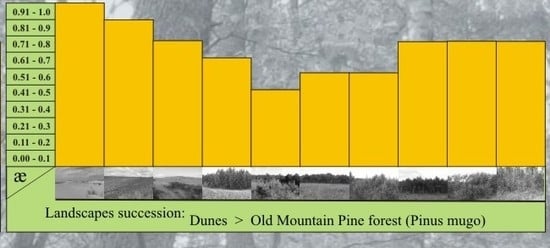Key Aesthetic Appeal Concepts of Coastal Dunes and Forests on the Example of the Curonian Spit (Lithuania)
Abstract
1. Introduction
2. Materials and Methods
- Stewardship (the presence of a sense of order and care contributing to perceived accordance with an “ideal” situation and reflecting care for the landscape through management).
- Coherence (a reflection of the unity of a scene enhanced through repeating patterns of color and texture, and a reflection of the correspondence between land use and natural conditions).
- Disturbance (lack of contextual fit and coherence where elements deviate from the context due to temporary and permanent interventions occurring in the landscape).
- Historicity (historical continuity reflecting the visual presence of different time layers and historical richness related to the amount, the condition, and the diversity of cultural elements).
- Visual scale (perceptual units reflecting the experience of landscape visibility and openness).
- Imageability (qualities of a landscape present in totality or through elements; landmarks and unique features, both natural and cultural, making the landscape create a strong visual image in the observer and making landscapes distinguishable and memorable).
- Complexity (diversity and richness of landscape elements and features and their interspersion).
- Naturalness (closeness to a preconceived natural state).
- Ephemera (elements and land-cover types changing with season and weather).
3. Results
4. Discussion
5. Conclusions
Author Contributions
Funding
Conflicts of Interest
References
- Bürgi, M.; Silbernagel, J.; Wu, J.; Kienast, F. Linking ecosystem services with landscape history. Landsc. Ecol. 2015, 30, 11–20. [Google Scholar] [CrossRef]
- Robert, S. Assessing the visual landscape potential of coastal territories for spatial planning. A case study in the French Mediterranean. Land Use Policy 2018, 72, 138–151. [Google Scholar] [CrossRef]
- Anfuso, G.; Williams, A.T.; Rangel-Buitrago, N. Examples of Class Divisions and Country Synopsis for Coastal Scenic Evaluations. In Coastal Scenery: Evaluation and Management; Rangel-Buitrago, N., Ed.; Springer: Cham, Switzerland, 2018; pp. 143–210. [Google Scholar]
- Armaitienė, A.; Boldyrev, V.L.; Povilanskas, R.; Taminskas, J. Integrated shoreline management and tourism development on the cross-border World Heritage Site: A case study from the Curonian Spit (Lithuania/Russia). J. Coast. Conserv. 2007, 11, 13–22. [Google Scholar] [CrossRef]
- Ergin, A.; Williams, A.T.; Micallef, A. Coastal scenery: Appreciation and evaluation. J. Coast. Res. 2006, 22, 958–964. [Google Scholar] [CrossRef]
- Iglesias, B.; Anfuso, G.; Uterga, A.; Arenas, P.; Williams, A.T. Scenic value of the Basque Country and Catalonia coasts (Spain): Impacts of tourist occupation. J. Coast. Conserv. 2018, 22, 247–261. [Google Scholar] [CrossRef]
- Mooser, A.; Anfuso, G.; Mestanza, C.; Williams, A.T. Management Implications for the Most Attractive Scenic Sites along the Andalusia Coast (SW Spain). Sustainability 2018, 10, 1328. [Google Scholar] [CrossRef]
- Phillips, M.R.; Edwards, A.M.; Williams, A.T. An incremental scenic assessment of the Glamorgan Heritage Coast, UK. Geogr. J. 2010, 176, 291–303. [Google Scholar] [CrossRef]
- Anfuso, G.; Williams, A.T.; Cabrera Hernández, J.A.; Pranzini, E. Coastal scenic assessment and tourism management in western Cuba. Tour. Manag. 2014, 42, 307–320. [Google Scholar] [CrossRef]
- Anfuso, G.; Williams, A.T.; Casas Martínez, G.; Botero, C.M.; Cabrera Hernández, J.A.; Pranzini, E. Evaluation of the scenic value of 100 beaches in Cuba: Implications for coastal tourism management. Ocean Coast. Manag. 2017, 142, 173–185. [Google Scholar] [CrossRef]
- Da Costa, C.S.; Portz, L.C.; Anfuso, G.; Camboim Rockett, G.; Guimarães Barboza, E. Coastal scenic evaluation at Santa Catarina (Brazil): Implications for coastal management. Ocean Coast. Manag. 2018, 160, 146–157. [Google Scholar] [CrossRef]
- De Araújo, M.C.B.; Da Costa, M.F. Environmental quality indicators for recreational beaches classification. J. Coast. Res. 2008, 24, 1439–1449. [Google Scholar] [CrossRef]
- Ergin, A. Coastal Scenery Assessment by Means of a Fuzzy Logic Approach. In Coastal Scenery: Evaluation and Management; Rangel-Buitrago, N., Ed.; Springer: Cham, Switzerland, 2018; pp. 67–106. [Google Scholar]
- Pranzini, E.; Williams, A.T.; Rangel-Buitrago, N. Coastal Scenery Assessment: Definitions and Typology. In Coastal Scenery: Evaluation and Management; Rangel-Buitrago, N., Ed.; Springer: Cham, Switzerland, 2018; pp. 107–142. [Google Scholar]
- Williams, A.T. The Concept of Scenic Beauty in a Landscape. In Coastal Scenery: Evaluation and Management; Rangel-Buitrago, N., Ed.; Springer: Cham, Switzerland, 2018; pp. 17–42. [Google Scholar]
- Williams, A.T. Some Scenic Evaluation Techniques. In Coastal Scenery: Evaluation and Management; Rangel-Buitrago, N., Ed.; Springer: Cham, Switzerland, 2018; pp. 43–66. [Google Scholar]
- Atauri, J.A.; Bravo, M.A.; Ruiz, A. Visitors’ Landscape Preferences as a Tool for Management of Recreational Use in Natural Areas: A case study in Sierra de Guadarrama (Madrid, Spain). Landsc. Res. 2000, 25, 49–62. [Google Scholar] [CrossRef]
- Povilanskas, R.; Armaitienė, A.; Dyack, B.; Jurkus, E. Islands of prescription and islands of negotiation. J. Destin. Market. Manag. 2016, 5, 260–274. [Google Scholar] [CrossRef]
- Povilanskas, R.; Baziukė, D.; Dučinskas, K.; Urbis, A. Can visitors visually distinguish successive coastal landscapes? A case study from the Curonian Spit (Lithuania). Ocean Coast. Manag. 2016, 119, 109–118. [Google Scholar] [CrossRef]
- Urry, J. The Tourist Gaze: Leisure and Travel in Contemporary Societies, 2nd ed.; Sage Publications: London, UK; Thousand Oaks, FL, USA; New Delhi, India, 2002; 176p. [Google Scholar]
- Huang, S.-C.L. Visitor responses to the changing character of the visual landscape as an agrarian area becomes a tourist destination: Yilan County, Taiwan. J. Sustain. Tour. 2013, 21, 154–171. [Google Scholar] [CrossRef]
- Lothian, A. Landscape and the philosophy of aesthetics: Is landscape quality inherent in the landscape or in the eye of the beholder? Landsc. Urban Plan. 1999, 44, 177–198. [Google Scholar] [CrossRef]
- Smardon, R.C.; Appleyard, D.; Sheppard, S.R.J.; Newman, S. Prototype: A Visual Impact Assessment Manual; Syracuse State University: New York, NY, USA, 1979; 88p. [Google Scholar]
- Jacobsen, J.K.S. Use of Landscape Perception Methods in Tourism Studies: A Review of Photo-Based Research Approaches. Tour. Geogr. 2007, 9, 234–253. [Google Scholar] [CrossRef]
- Zube, E.H.; Sell, J.L.; Taylor, J.G. Landscape perception—Research, application and theory. Landsc. Plan. 1982, 9, 1–33. [Google Scholar] [CrossRef]
- Daniel, T.C.; Arthur, L.M.; Boster, R.S. Scenic assessment: An overview. Landsc. Plan. 1977, 4, 109–129. [Google Scholar]
- Daniel, T.C.; Vining, J. Methodological issues in the assessment of landscape quality. In Behavior and the Natural Environment; Altman, I., Wohwill, J., Eds.; Plenum Press: New York, NY, USA, 1983; pp. 39–83. [Google Scholar]
- Uzzell, D. Environmental psychological perspectives on landscape. Landsc. Res. 1991, 16, 3–10. [Google Scholar] [CrossRef]
- Jorgensen, A. Beyond the view: Future directions in landscape aesthetics research. Landsc. Urban Plan. 2011, 100, 353–355. [Google Scholar] [CrossRef]
- Ribe, R.G. Is Scenic Beauty a Proxy for Acceptable Management? The Influence of Environmental Attitudes on Landscape Perceptions. Environ. Behav. 2002, 34, 757–780. [Google Scholar] [CrossRef]
- Hull, R.B.; Buhyoff, G.J.; Daniel, T.C. Measurement of scenic beauty: The law of comparative judgment and scenic beauty estimation procedures. For. Sci. 1984, 30, 1084–1096. [Google Scholar]
- Wherrett, J.R. Creating Landscape Preference Models Using Internet Survey Techniques. Landsc. Res. 2000, 25, 79–96. [Google Scholar] [CrossRef]
- Rolloff, D.B. Scenic Quality at Crater Lake National Park: Visitor Perceptions of Natural and Human Influence. Ph.D. Thesis, Oregon State University, Corvallis, OR, USA, 1998. [Google Scholar]
- Vining, J.; Stevens, J.J. The assessment of landscape quality: Major methodological considerations. In Foundations for Visual Project Analysis; Smardon, R.C., Palmer, J.F., Felleman, J.P., Eds.; John Wiley: New York, NY, USA, 1986; pp. 167–186. [Google Scholar]
- De Vries, S.; de Groot, M.; Boers, J. Eyesores in sight: Quantifying the impact of man-made elements on the scenic beauty of Dutch landscapes. Landsc. Urban Plan. 2012, 105, 118–127. [Google Scholar] [CrossRef]
- Karjalainen, E.; Tyrväinen, L. Visualization in forest landscape preference research: A Finnish perspective. Landsc. Urban Plan. 2002, 59, 13–28. [Google Scholar] [CrossRef]
- Buhyoff, G.J.; Miller, P.A.; Roach, J.W.; Zhou, D.; Fuller, L.G. An AI methodology for landscape visual assessments. AI Appl. 1994, 8, 1–13. [Google Scholar]
- Petrova, E.G.; Mironov, Y.V.; Aoki, Y.; Matsushima, H.; Ebine, S.; Furuya, K.; Petrova, A.; Takayama, N.; Ueda, H. Comparing the visual perception and aesthetic evaluation of natural landscapes in Russia and Japan: Cultural and environmental factors. Prog. Earth Planet. Sci. 2015, 2, 6. [Google Scholar] [CrossRef]
- Hull, R.B.; Revell, G.R.B. Issues in sampling landscapes for visual quality assessments. Landsc. Urban Plan. 1989, 17, 323–330. [Google Scholar] [CrossRef]
- Appleton, J. The Experience of Landscape, 2nd ed.; John Wiley: New York, NY, USA, 1996; 282p. [Google Scholar]
- Kaltenborn, B.P.; Bjerke, T. Associations between Landscape Preferences and Place Attachment: A study in Røros, Southern Norway. Landsc. Res. 2002, 27, 381–396. [Google Scholar] [CrossRef]
- Kaplan, R.; Kaplan, S. The Experience of Nature: A Psychological Perspective; Cambridge University Press: New York, NY, USA, 1989; 340p. [Google Scholar]
- Zube, E.H. Perceived land use patterns and landscape values. Landsc. Ecol. 1987, 1, 37–45. [Google Scholar] [CrossRef]
- Wells, S. The Journey of Man: A Genetic Odyssey; Princeton University Press: Princeton, NJ, USA; Oxford, UK, 2002; 240p. [Google Scholar]
- Bell, S. Landscape: Pattern, Perception and Process, 2nd ed.; Taylor and Francis: London, UK; New York, NY, USA, 2013; 352p. [Google Scholar]
- Nassauer, J.I. Culture and changing landscape structure. Landsc. Ecol. 1995, 10, 229–237. [Google Scholar] [CrossRef]
- Buhyoff, G.J.; Wellman, D.J.; Koch, N.E.; Gauthier, L.; Hultman, S.G. Landscape preference metrics: An international comparison. J. Environ. Manag. 1983, 16, 181–190. [Google Scholar]
- De la Fuente de Val, G.; Mühlhauser, H.S. Visual quality: An examination of a South American Mediterranean landscape, Andean foothills east of Santiago (Chile). Urban For. Urban Green. 2014, 13, 261–271. [Google Scholar] [CrossRef]
- Lewis, J.L. Challenges of interdisciplinarity for forest management and landscape perception research. In From Landscape Research to Landscape Planning: Aspects of Integration, Education and Application; Tress, B., Tress, G., Fry, G., Opdam, P., Eds.; Springer: Dordrecht, The Netherlands, 2006; pp. 83–94. [Google Scholar]
- Tveit, M.; Ode, Å.; Fry, G. Key Concepts in a Framework for Analysing Visual Landscape Character. Landsc. Res. 2006, 31, 229–255. [Google Scholar] [CrossRef]
- Daniel, T.C. Whither scenic beauty? Visual landscape quality assessment in the 21st century. Landsc. Urban Plan. 2001, 54, 267–281. [Google Scholar] [CrossRef]
- Gobster, P.H.; Westphal, L.M. The human dimensions of urban greenways: Planning for recreation and related experiences. Landsc. Urban Plan. 2004, 68, 147–165. [Google Scholar] [CrossRef]
- Jorgensen, A.; Hitchmough, J.; Calvert, T. Woodland spaces and edges: Their impact on perception of safety and preference. Landsc. Urban Plan. 2002, 60, 135–150. [Google Scholar] [CrossRef]
- Krause, C.L. Our visual landscape: Managing the landscape under special consideration of visual aspects. Landsc. Urban Plan. 2001, 54, 239–254. [Google Scholar] [CrossRef]
- Povilanskas, R.; Chubarenko, B.V. Interaction between the drifting dunes of the Curonian Barrier Spit and the Curonian Lagoon. Baltica 2000, 13, 8–14. [Google Scholar]
- Povilanskas, R. Landscape Management on the Curonian Spit: A Cross-border Perspective; EUCC Publishers: Klaipėda, Lithuania, 2004; 242p. [Google Scholar]
- Povilanskas, R. Spatial diversity of modern geomorphological processes on a Holocene Dune Ridge on the Curonian Spit in the South–East Baltic. Baltica 2009, 22, 77–88. [Google Scholar]
- Povilanskas, R.; Baghdasarian, H.; Arakelyan, S.; Satkūnas, J.; Taminskas, J. Secular Morphodynamic Trends of the Holocene Dune Ridge on the Curonian Spit (Lithuania/Russia). J. Coast. Res. 2009, 25, 209–215. [Google Scholar]
- Povilanskas, R.; Satkūnas, J.; Taminskas, J. Results of cartometric investigations of dune morphodynamics on the Curonian Spit. Geologija 2006, 53, 22–27. [Google Scholar]
- Gudelis, V. The Coast and the Offshore of Lithuania; Academia: Vilnius, Lithuania, 1998; 442p. [Google Scholar]
- Van der Meulen, F.; Jungerius, P.D.; Visser, J. Editorial. In Perspectives in Coastal Dune Management; Van der Meulen, F., Jungerius, P.D., Visser, J., Eds.; SPB Academic Publishing: The Hague, The Netherlands, 1989; pp. 1–7. [Google Scholar]
- Povilanskas, R.; Riepšas, E.; Armaitienė, A.; Dučinskas, K.; Taminskas, J. Mobile Dune Types of the Curonian Spit and Factors of Their Development. Balt. For. 2011, 17, 215–226. [Google Scholar]
- Garrod, B. Exploring Place Perception: A Photo-based Analysis. Ann. Tour. Res. 2008, 35, 381–401. [Google Scholar] [CrossRef]
- Rangel-Buitrago, N.; Williams, A.T.; Ergin, A.; Anfuso, G.; Micallef, A.; Pranzini, E. Coastal Scenery: An Introduction. In Coastal Scenery: Evaluation and Management; Rangel-Buitrago, N., Ed.; Springer: Cham, Switzerland, 2018; pp. 1–17. [Google Scholar]
- De la Fuente de Val, G.; Atauri, J.A.; de Lucio, J.V. Relationship between landscape visual attributes and spatial pattern indices: A test study in Mediterranean-climate landscapes. Landsc. Urban Plan. 2006, 77, 393–407. [Google Scholar] [CrossRef]
- Múgica, M.; de Lucio, J.V. The role of on-site experience on landscape preferences. A case study at Doñana National Park (Spain). J. Environ. Manag. 1996, 47, 229–239. [Google Scholar] [CrossRef]
- Palmer, J.F.; Hoffman, R.E. Rating reliability and representation validity in scenic landscape assessments. Landsc. Urban Plan. 2001, 54, 149–161. [Google Scholar] [CrossRef]
- Urbis, A.; Povilanskas, R.; Newton, A. Valuation of aesthetic ecosystem services of protected coastal dunes and forests. Ocean Coast Manag. 2019, 179. in press. [Google Scholar] [CrossRef]
- Stamps, A.E. Mystery, complexity, legibility and coherence: A meta-analysis. J. Environ. Psychol. 2004, 24, 1–16. [Google Scholar] [CrossRef]
- Mowforth, M.; Munt, I. Tourism and Sustainability: Development, Globalisation and New Tourism in the Third World, 3rd ed.; Routledge: London, UK, 2009; 456p. [Google Scholar]
- Poria, Y.; Butler, R.; Airey, D. The core of heritage tourism. Ann. Tour. Res. 2003, 30, 238–254. [Google Scholar] [CrossRef]
- Eysenck, M. Memory. In Psychology: An Integrated Approach; Eysenck, M., Ed.; Longman: Essex, UK, 1998; pp. 167–204. [Google Scholar]
- Ode, Å.; Fry, G.; Tveit, M.S.; Messager, P.; Miller, D. Indicators of perceived naturalness as drivers of landscape preference. J. Environ. Manag. 2009, 90, 375–383. [Google Scholar] [CrossRef] [PubMed]
- Creswell, J.W. Research Design: Qualitative, Quantitative, and Mixed Methods Approaches, 4th ed.; Sage: Los Angeles, CA, USA, 2014; 273p. [Google Scholar]
- Garrod, B.; Fyall, A. Managing Heritage Tourism. Ann. Tour. Res. 2000, 27, 682–708. [Google Scholar] [CrossRef]
- Hsu, C.C.; Sandford, B.A. The Delphi technique: Making sense of consensus. Pract. Assess. Res. Eval. 2007, 12, 1–8. [Google Scholar]
- La Sala, P.; Conto, F.; Conte, A.; Fiore, M. Cultural Heritage in Mediterranean Countries: The Case of an IPA Adriatic Cross Border Cooperation Project. Int. J. Eur. Med. Stud. 2016, 9, 31–50. [Google Scholar]
- Lupp, G.; Konold, W.; Bastian, O. Landscape management and landscape changes towards more naturalness and wilderness: Effects on scenic qualities—The case of the Muritz National Park in Germany. J. Nat. Conserv. 2013, 21, 10–21. [Google Scholar] [CrossRef]
- Monavari, S.M.; Khorasani, N.; Mirsaeed, S.S.G. Delphi-based Strategic Planning for Tourism Management—A Case Study. Pol. J. Environ. Stud. 2013, 22, 465–473. [Google Scholar]
- Olszewska, A.A.; Marques, P.F.; Ryan, R.L.; Barbosa, F. What makes a landscape contemplative? Environ. Plan. B Urban Anal. City Sci. 2018, 45, 7–25. [Google Scholar] [CrossRef]
- Tan, W.J.; Yang, C.F.; Château, P.A.; Lee, M.T.; Chang, Y.C. Integrated coastal-zone management for sustainable tourism using a decision support system based on system dynamics: A case study of Cijin, Kaohsiung, Taiwan. Ocean Coast Manag. 2018, 153, 131–139. [Google Scholar] [CrossRef]
- Palmer, J.F. Reliability of Rating Visible Landscape Qualities. Landsc. J. 2000, 19, 166–178. [Google Scholar] [CrossRef]
- Parsons, R.; Daniel, T.C. Good looking: In defense of scenic landscape aesthetics. Landsc. Urban Plan. 2002, 60, 43–56. [Google Scholar] [CrossRef]
- Van Mansvelt, J.D.; Kuiper, J. Criteria for the humanity realm: Psychology and physiognomy and cultural heritage. In Checklist for Sustainable Landscape Management; van Mansvelt, J.D., van der Lubbe, M.J., Eds.; Elsevier Science: Amsterdam, The Netherlands, 1999; pp. 116–134. [Google Scholar]
- Nohl, W. Sustainable landscape use and aesthetic perception-preliminary reflections on future landscape aesthetics. Landsc. Urban Plan. 2001, 54, 223–237. [Google Scholar] [CrossRef]
- Doody, J.P. Sand Dune Conservation, Management and Restoration; Springer: Dordrecht, The Netherlands, 2013; 304p. [Google Scholar]
- Sevenant, M.; Antrop, M. Cognitive attributes and aesthetic preferences in assessment and differentiation of landscapes. J. Environ. Manag. 2009, 90, 2889–2899. [Google Scholar] [CrossRef] [PubMed]
- Riepšas, E. Recreational Forestry; Aleksandras Stulginskis University Publishers: Kaunas, Lithuania, 2012; 256p. [Google Scholar]
- Green, R. Meaning and form in community perception of town character. J. Environ. Psychol. 1999, 19, 311–329. [Google Scholar] [CrossRef]
- Povilanskas, R.; Armaitienė, A. Marketing of coastal barrier spits as liminal spaces of creativity. Procedia Soc. Behav. Sci. 2014, 148, 397–403. [Google Scholar] [CrossRef]
- Weinstoerffer, J.; Girardin, P. Assessment of the contribution of land use pattern and intensity to landscape quality: Use of a landscape indicator. Ecol. Model. 2000, 130, 95–109. [Google Scholar] [CrossRef]
- Wu, J. Landscape of culture and culture of landscape: Does landscape ecology need culture? Landsc. Ecol. 2010, 25, 1147–1150. [Google Scholar] [CrossRef]
- Germino, M.J.; Reiners, W.A.; Blasko, B.J.; McLeod, D.; Bastian, C.T. Estimating visual properties of Rocky Mountain landscapes using GIS. Landsc. Urban Plan. 2001, 53, 71–84. [Google Scholar] [CrossRef]
- Chhetri, P.; Arrowsmith, C.; Jackson, M. Determining hiking experiences in nature-based tourist destinations. Tour. Manag. 2004, 25, 31–43. [Google Scholar] [CrossRef]
- Vouligny, É.; Domon, G.; Ruiz, J. An assessment of ordinary landscapes by an expert and by its residents: Landscape values in areas of intensive agricultural use. Land Use Policy 2009, 26, 890–900. [Google Scholar] [CrossRef]
- Chhetri, P.; Arrowsmith, C. GIS-based modelling of recreational potential of nature-based tourist destinations. Tour. Geogr. 2008, 10, 233–257. [Google Scholar] [CrossRef]
- Ruddell, E.; Gramann, J.; Rudis, V.; Westphal, J. The psychological utility of visual penetration in near-view forest scenic-beauty models. Environ. Behav. 1989, 214, 393–412. [Google Scholar] [CrossRef]
- Roth, M.; Hildebrandt, S.; Röhner, S.; Tilk, C.; von Raumer, H.G.S.; Roser, F.; Borsdorff, M. Landscape as an area as perceived by people: Empirically-based nationwide modelling of scenic landscape quality in Germany. J. Dig. Landsc. Archit. 2018, 3, 129–137. [Google Scholar]
- Thiele, J.; von Haaren, C.; Albert, C. Are river landscapes outstanding in providing cultural ecosystem services? An indicator-based exploration in Germany. Ecol. Indic. 2019, 101, 31–40. [Google Scholar] [CrossRef]
- Cassatella, C.; Seardo, B.M. In search for multifunctionality: The contribution of scenic landscape assessment. In Landscape Planning and Rural Development; Cassatella, C., Ed.; Springer: Cham, Switzerland, 2014; pp. 41–60. [Google Scholar]
- Ayad, Y.M. Remote sensing and GIS in modeling visual landscape change: A case study of the northwestern arid coast of Egypt. Landsc. Urban Plan. 2005, 73, 307–325. [Google Scholar] [CrossRef]
- Opdam, P.; Luque, S.; Nassauer, J.; Verburg, P.H.; Wu, J. How can landscape ecology contribute to sustainability science? Landsc. Ecol. 2018, 33, 1–7. [Google Scholar] [CrossRef]
- Doody, J.P. “Coastal squeeze”: An historical perspective. J. Coast. Conserv. 2004, 10, 129–138. [Google Scholar] [CrossRef]
- Powell, E.J.; Tyrrell, M.C.; Milliken, A.; Tirpak, J.M.; Staudinger, M.D. A review of coastal management approaches to support the integration of ecological and human community planning for climate change. J. Coast. Conserv. 2019, 23, 1–18. [Google Scholar] [CrossRef]
- Dalton, T.; Thompson, R. Recreational boaters’ perceptions of scenic value in Rhode Island coastal waters. Ocean Coast. Manag. 2013, 71, 99–107. [Google Scholar] [CrossRef]
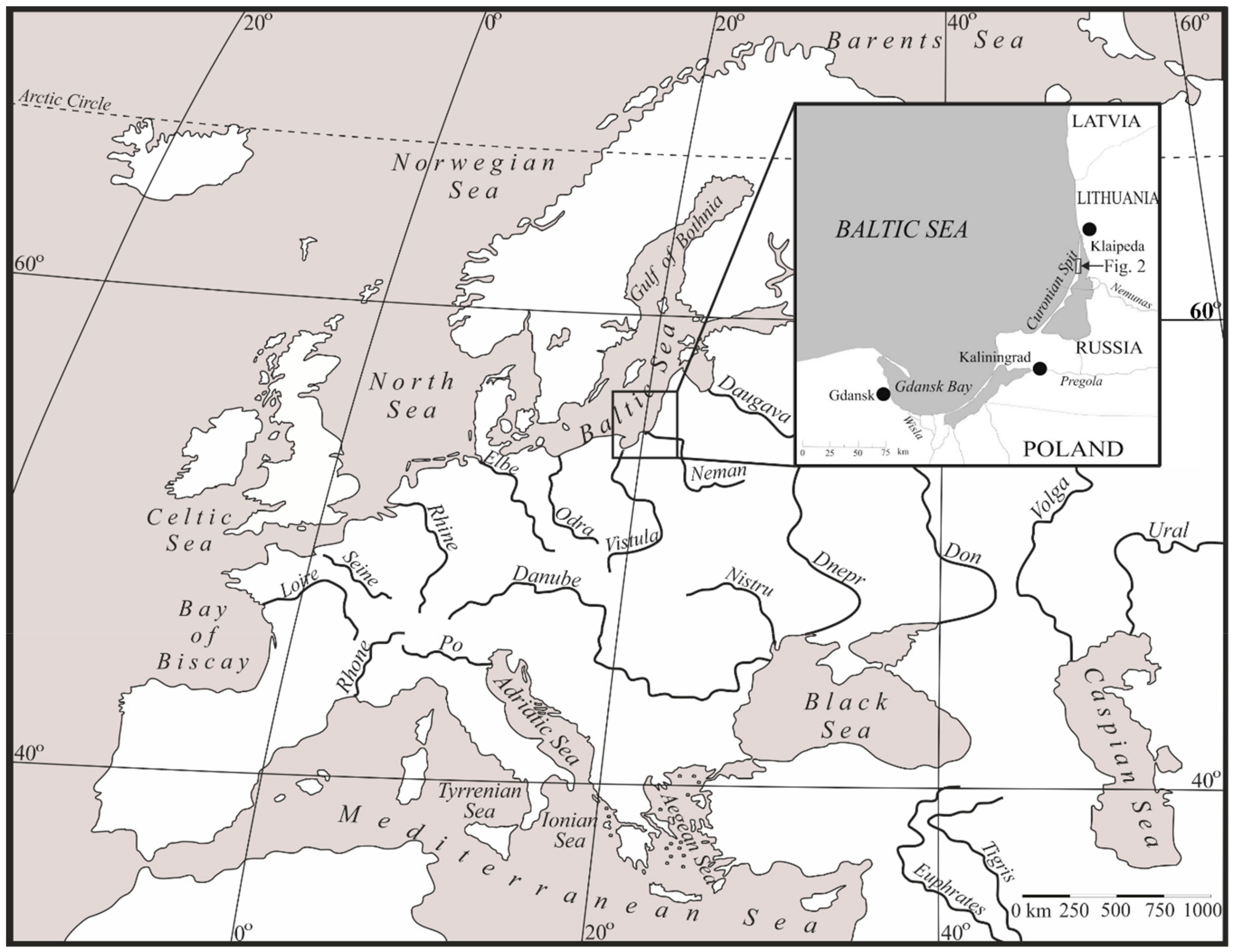


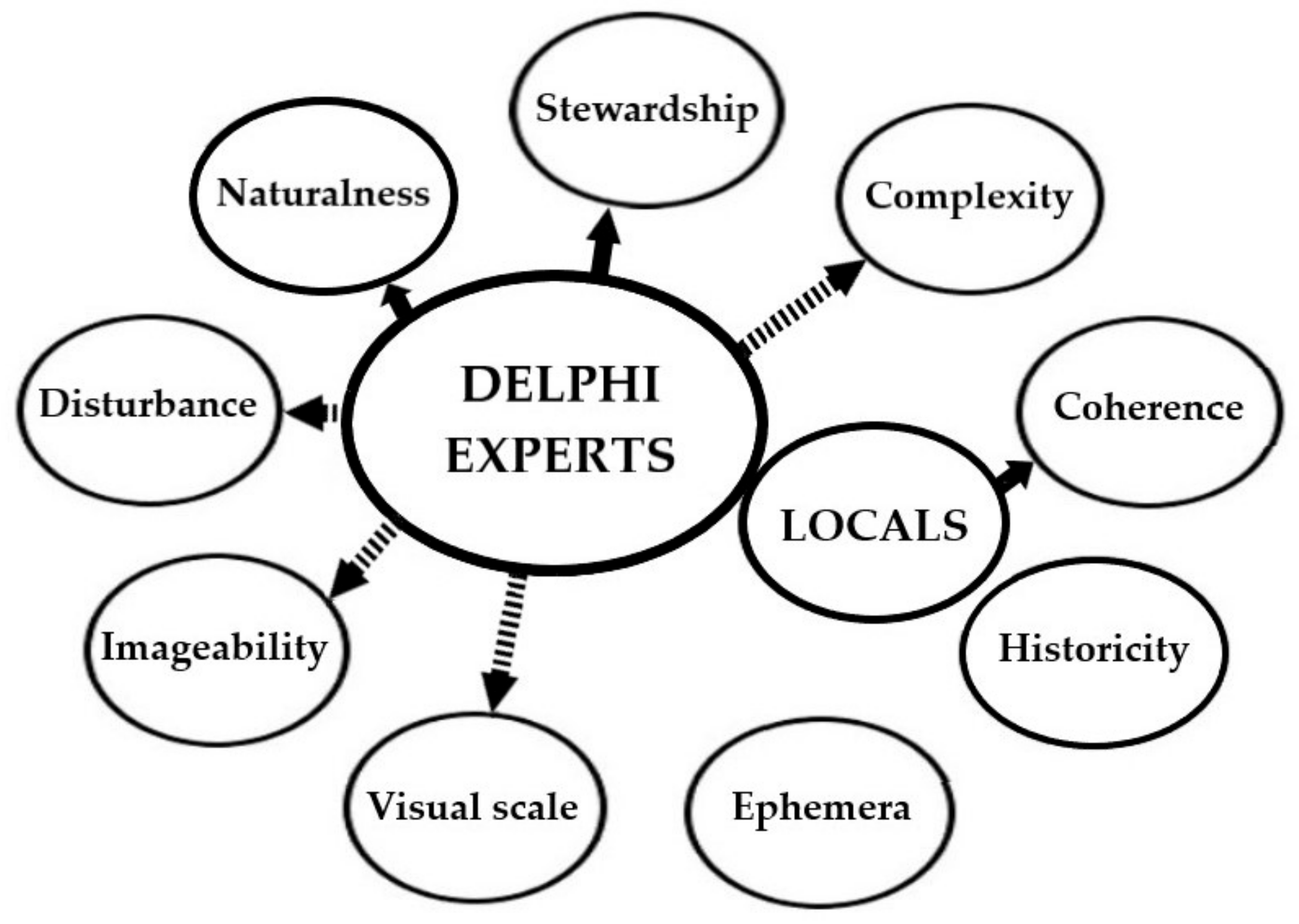
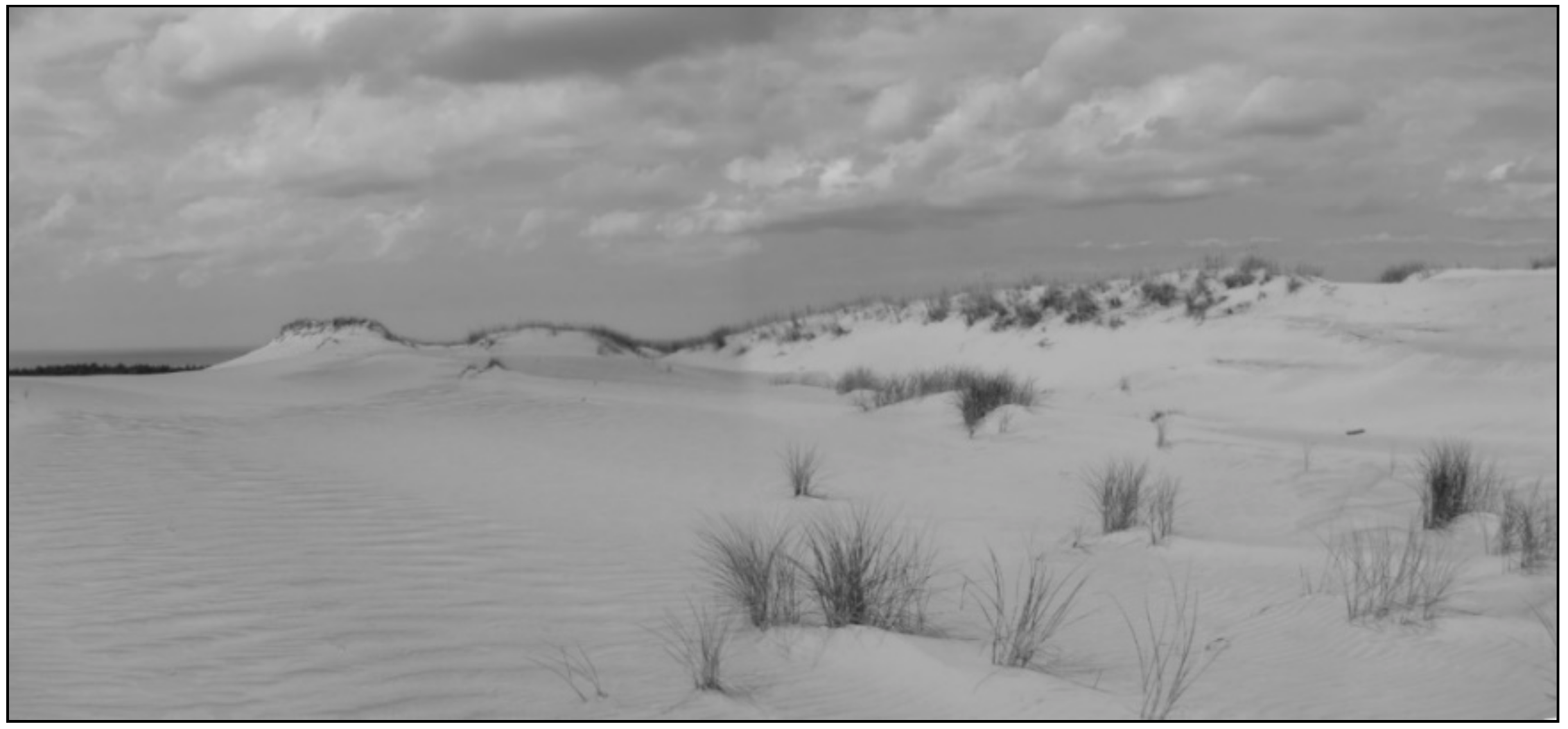
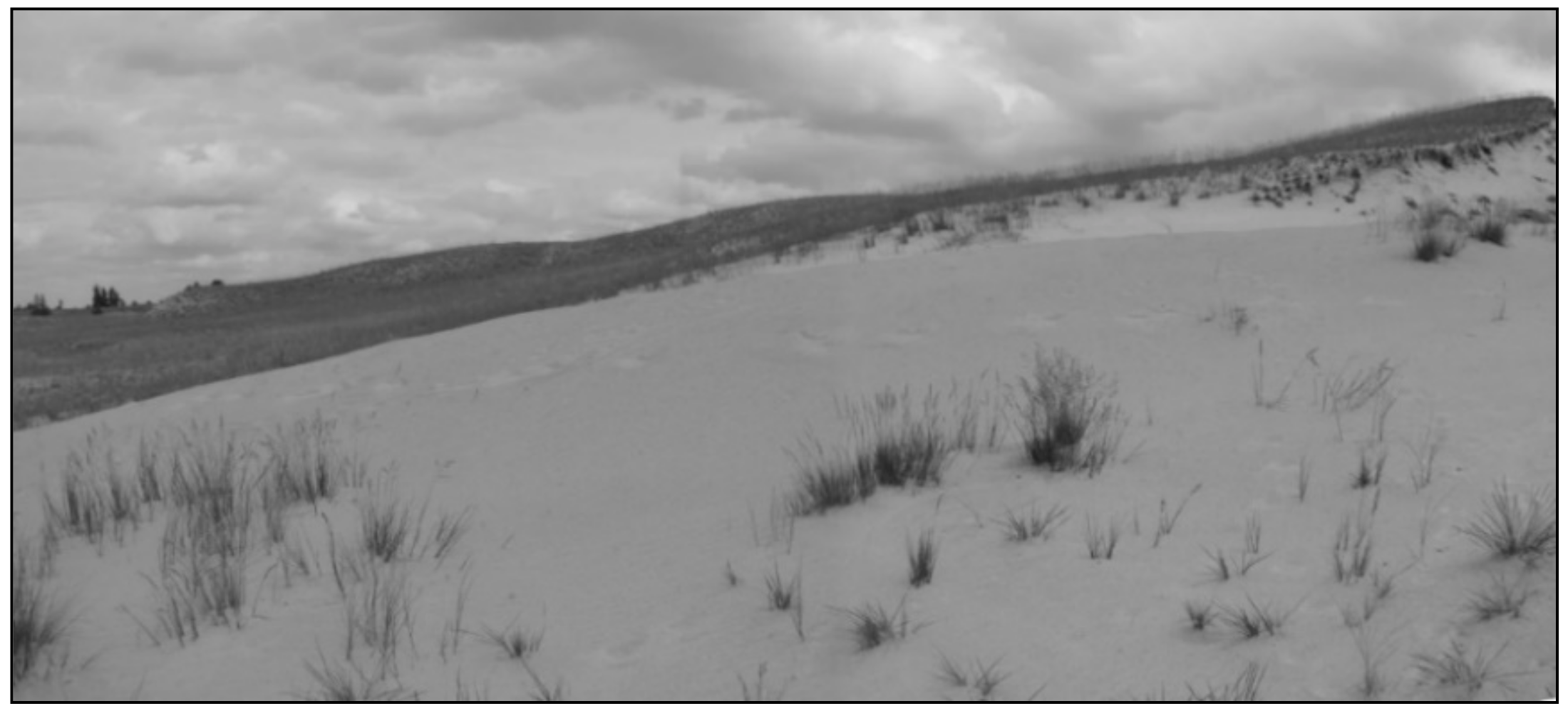
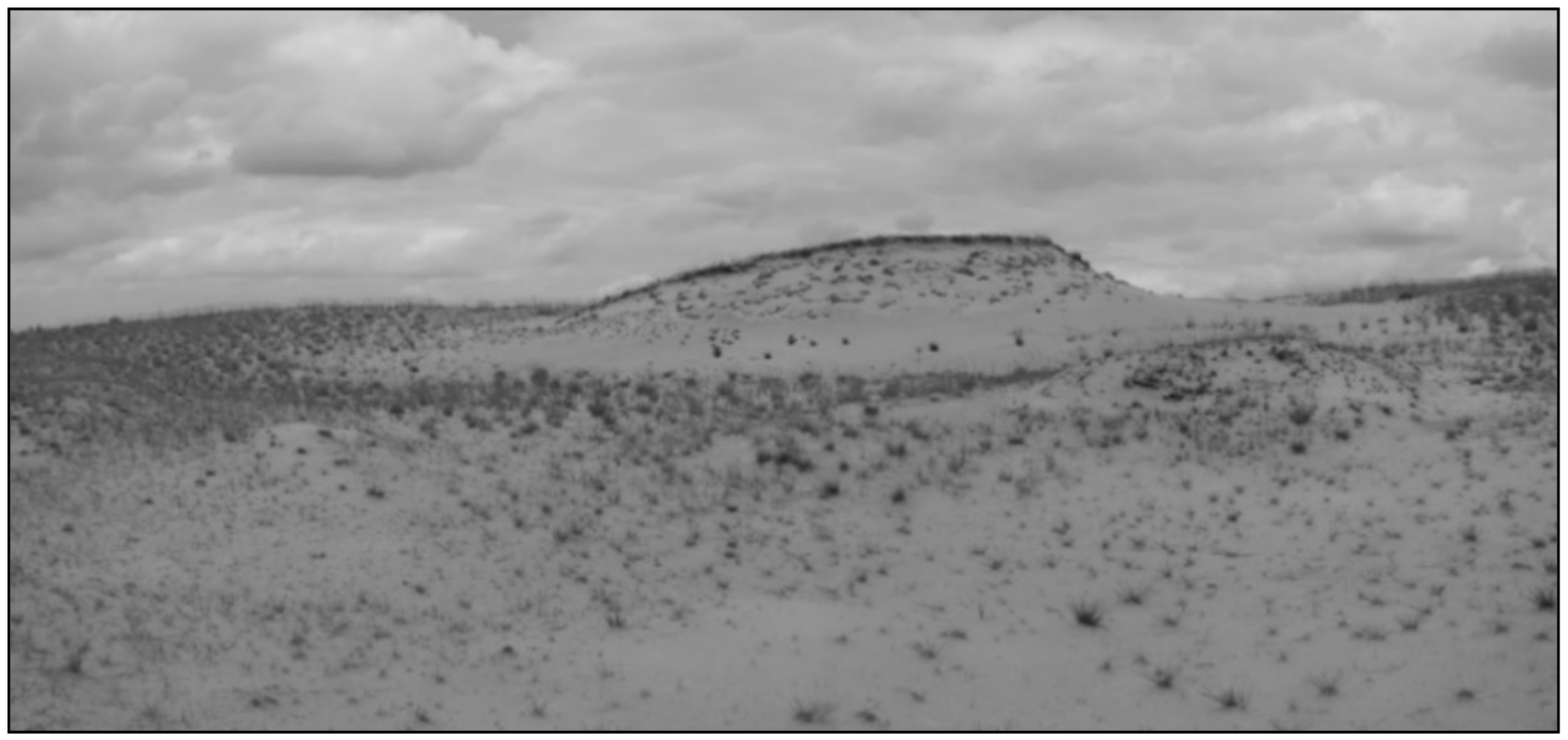

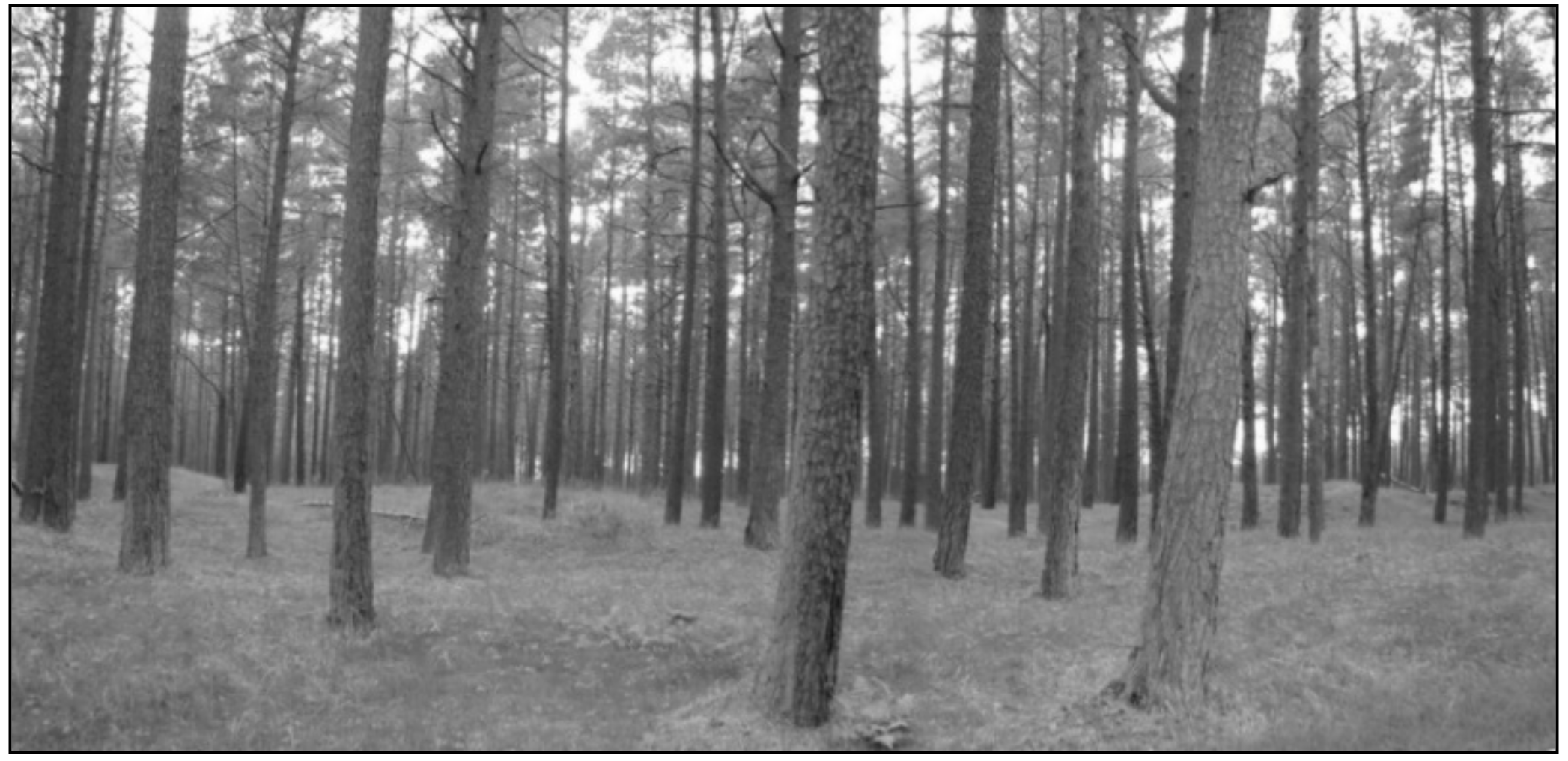
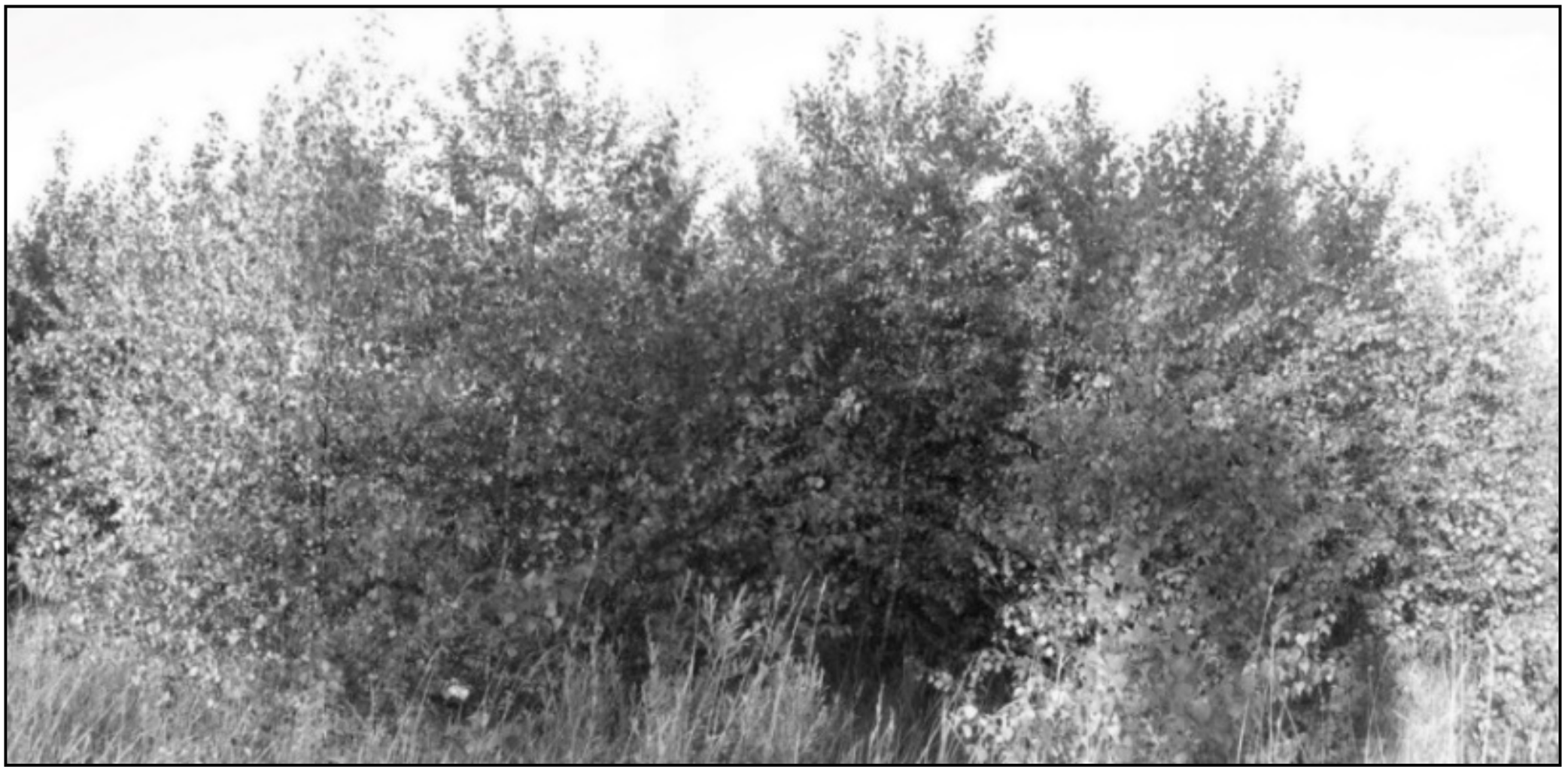
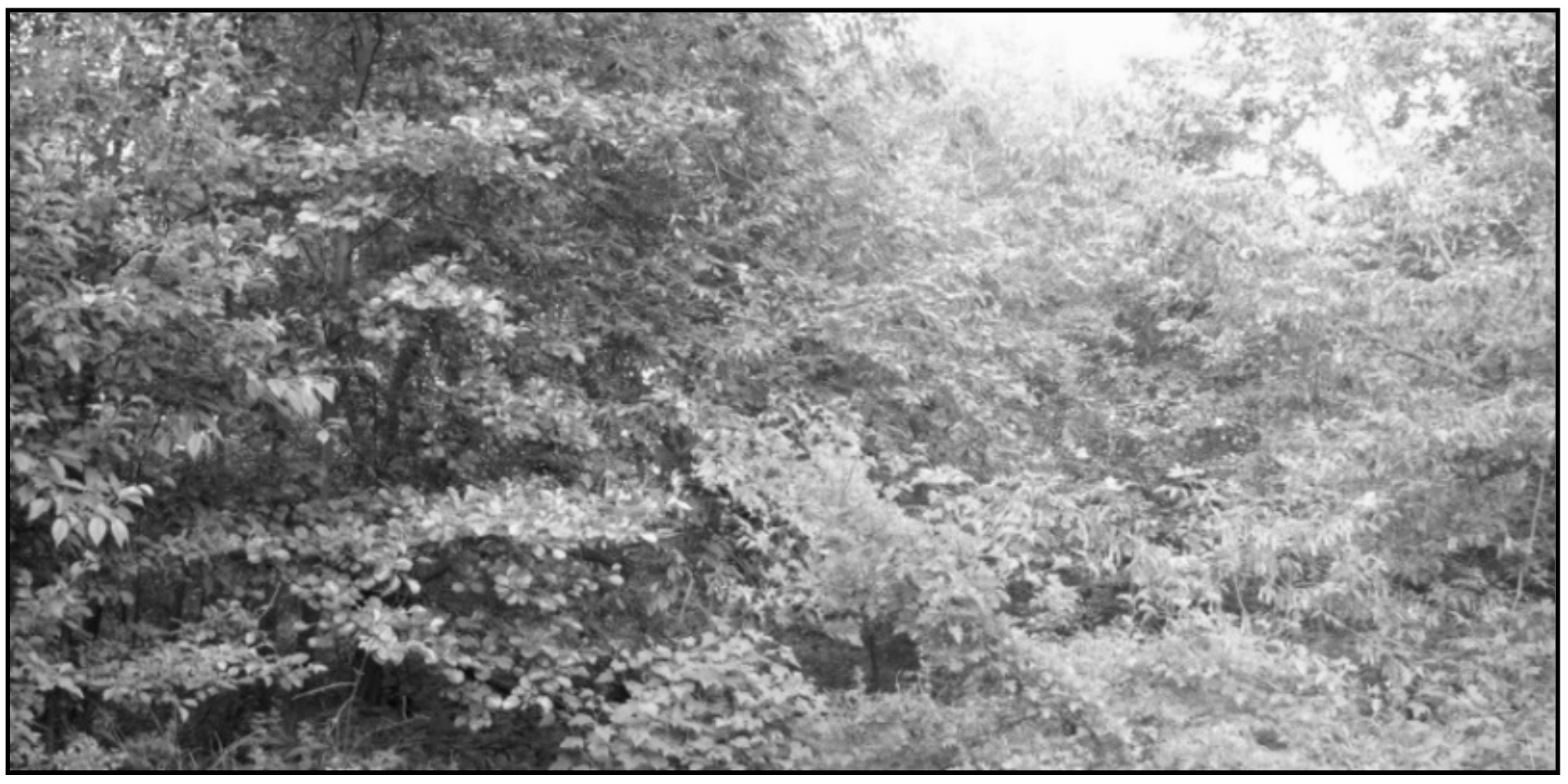
| Authors | Paradigms | |||
|---|---|---|---|---|
| Objectivist (Physical) | Subjectivist (Psychological) | |||
| Lothian [22], Zube et al. [25] | Expert | Psychophysical | Cognitive | Experiential |
| Daniel and Vining [27] Uzzell [28] | Ecological/Formal aesthetic | Psychophysical | Psychological | Phenomenological |
| Sample Characteristics and Survey Methods | Quantitative Survey | Qualitative Survey |
|---|---|---|
| Number of respondents | 1485 | 12 |
| Representativity | Representative sample of domestic summer visitors | Representative sample of local stakeholders |
| Survey method applied | Paired comparison survey | Semi-structured face-to-face interviews |
| Survey months | July, August | April, February |
| Average duration | ~15 min. | 25–30 min. |
| Number of landscape types | 45 | 45 |
| Number of photographs | 135 | 135 |
| Additional questions asked | Socio-demographic questions (age, gender, residence, visit frequency) | Socio-demographic questions and opinion about the presented landscape appeal concepts |
| Rank | Normalized Rating | Landscape Type | Key Concepts [50] | |
|---|---|---|---|---|
| Primary Concept | Secondary Concept | |||
| 1. | 1.00 | White (open) mobile dunes (Figure 5) | Naturalness | Imageability |
| 2. | 0.92 | White dunes with grey dunes (Figure 6) | Naturalness | Visual scale |
| 3. | 0.91 | Grey dunes with white dunes (Figure 7) | Naturalness | Visual scale |
| 4. | 0.82 | Mature Scots pine with grey dunes (Figure 8) | Stewardship | Visual scale |
| 5. | 0.79 | Mature Scots pine (Figure 9) | Stewardship | Visual scale |
| 6. | 0.76 | Young Scots pine with Grey dunes | n.a. | n.a. |
| 7. | 0.76 | Grey dunes | n.a. | n.a. |
| 8. | 0.74 | Middle-aged Silver birch | n.a. | n.a. |
| 9. | 0.73 | Mature Norway spruce | n.a. | n.a. |
| 10. | 0.69 | Middle-aged Scots pine with Mugo pine | n.a. | n.a. |
| 11. | 0.69 | Mature and middle-aged Scots pine | n.a. | n.a. |
| 12. | 0.68 | Forest glade in mature Scots pine stands | n.a. | n.a. |
| 13. | 0.68 | Mature Silver birch | n.a. | n.a. |
| 14. | 0.68 | Mature Silver birch with dry grasslands | n.a. | n.a. |
| 15. | 0.67 | Mature Silver birch with Scots pine | n.a. | n.a. |
| 16. | 0.66 | Dry grasslands | n.a. | n.a. |
| 17. | 0.62 | Middle-aged and young Scots pine | n.a. | n.a. |
| 18. | 0.59 | Grey dunes with middle-aged Scots pine | n.a. | n.a. |
| 19. | 0.59 | Young Scots pine stands with Mugo pine | n.a. | n.a. |
| 20. | 0.59 | Young and mature Norway spruce | n.a. | n.a. |
| 21. | 0.59 | Middle-aged Scots pine | n.a. | n.a. |
| 22. | 0.59 | Middle-aged Black alder | n.a. | n.a. |
| 23. | 0.59 | Middle-aged Norway spruce | n.a. | n.a. |
| 24. | 0.59 | Mature and middle-aged Norway spruce | n.a. | n.a. |
| 25. | 0.58 | Juniper brushwood | n.a. | n.a. |
| 26. | 0.58 | Young and middle-aged Scots pine | n.a. | n.a. |
| 27. | 0.58 | Mature Silver birch with Norway spruce | n.a. | n.a. |
| 28. | 0.57 | Grey dunes with young Scots pine | n.a. | n.a. |
| 29. | 0.57 | Young Scots pine | n.a. | n.a. |
| 30. | 0.56 | Mugo pine with middle-aged Scots pine | n.a. | n.a. |
| 31. | 0.52 | Young Norway spruce | n.a. | n.a. |
| 32. | 0.52 | Mature Black alder forest | n.a. | n.a. |
| 33. | 0.49 | Dry grasslands with Mugo pine | n.a. | n.a. |
| 34. | 0.48 | Middle-aged Scots pine with Grey dunes | n.a. | n.a. |
| 35. | 0.47 | Juniper with middle-aged Scots pine | n.a. | n.a. |
| 36. | 0.46 | Willow stands with young Scots pine | n.a. | n.a. |
| 37. | 0.45 | Grey dunes with Willow stands | n.a. | n.a. |
| 38. | 0.45 | Mugo pine plantation | n.a. | n.a. |
| 39. | 0.42 | Young and mature Silver birch | n.a. | n.a. |
| 40. | 0.42 | Willow stands with Grey dunes | n.a. | n.a. |
| 41. | 0.39 | Middle-aged Scots pine with Juniper | Naturalness | Disturbance |
| 42. | 0.39 | Mature and middle-aged Black alder | Naturalness | Disturbance |
| 43. | 0.35 | Young Silver birch (Figure 10) | Naturalness | Disturbance |
| 44. | 0.35 | Young Black alder | Naturalness | Complexity |
| 45. | 0.34 | Deciduous forest clearing (Figure 11) | Naturalness | Complexity |
© 2019 by the authors. Licensee MDPI, Basel, Switzerland. This article is an open access article distributed under the terms and conditions of the Creative Commons Attribution (CC BY) license (http://creativecommons.org/licenses/by/4.0/).
Share and Cite
Urbis, A.; Povilanskas, R.; Šimanauskienė, R.; Taminskas, J. Key Aesthetic Appeal Concepts of Coastal Dunes and Forests on the Example of the Curonian Spit (Lithuania). Water 2019, 11, 1193. https://doi.org/10.3390/w11061193
Urbis A, Povilanskas R, Šimanauskienė R, Taminskas J. Key Aesthetic Appeal Concepts of Coastal Dunes and Forests on the Example of the Curonian Spit (Lithuania). Water. 2019; 11(6):1193. https://doi.org/10.3390/w11061193
Chicago/Turabian StyleUrbis, Arvydas, Ramūnas Povilanskas, Rasa Šimanauskienė, and Julius Taminskas. 2019. "Key Aesthetic Appeal Concepts of Coastal Dunes and Forests on the Example of the Curonian Spit (Lithuania)" Water 11, no. 6: 1193. https://doi.org/10.3390/w11061193
APA StyleUrbis, A., Povilanskas, R., Šimanauskienė, R., & Taminskas, J. (2019). Key Aesthetic Appeal Concepts of Coastal Dunes and Forests on the Example of the Curonian Spit (Lithuania). Water, 11(6), 1193. https://doi.org/10.3390/w11061193





